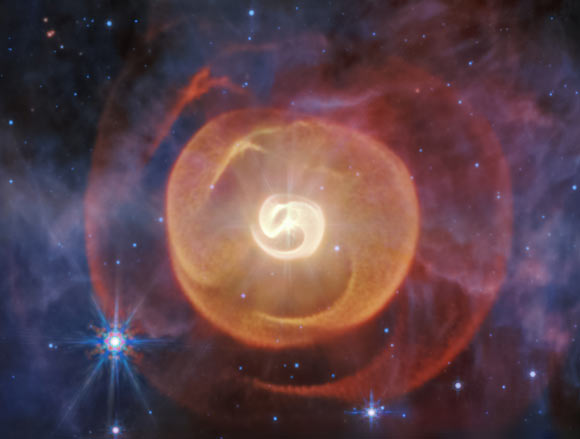Using the NASA/ESA/CSA James Webb Space Telescope with data from ESO’s Very Large Telescope (VLT), two team of astronomers have captured a mid-infrared image of a system of four serpentine spirals of dust around two aging Wolf-Rayet stars in a system known as Apep (2XMM J160050.7-514245).

Webb’s mid-infrared image shows four coiled shells of dust around a pair of Wolf-Rayet stars known as Apep. Image credit: NASA / ESA / CSA / STScI / Yinuo Han, Caltech / Ryan White, Macquarie University / Alyssa Pagan, STScI.
Wolf-Rayet stars are a rare class of massive binary stars, where the earliest carbon in the Universe is forged.
Only a thousand are estimated to exist in our Milky Way galaxy, which contains hundreds of billions of stars overall.
Of the few hundred Wolf-Rayet binaries that have been observed to date, the Apep system is the only example that contains two Wolf-Rayet stars of these types in our Milky Way Galaxy.
In new research, Macquarie University astronomer Ryan White and colleagues aimed to refine the orbit of the Wolf-Rayet stars in the Apep system.
They combined precise measurements of the ring location from the Webb image with the speed of the shells’ expansion from observations taken by the VLT over eight years.
“This is a one-of-a-kind system with an extremely long orbital period,” White said.
“The next longest orbit for a dusty Wolf-Rayet binary is about 30 years. Most have orbits between two to 10 years.”
The team’s paper was published simultaneously in the Astrophysical Journal with another paper, led by Caltech astronomer Yinuo Han.
“Looking at the new Webb observations was like walking into a dark room and switching on the light — everything came into view,” Dr. Han said.
“There is dust everywhere in the Webb image, and the telescope shows that most of it was cast off in repetitive, predictable structures.”
The Webb observations delivered a first of its kind: a crisp mid-infrared image of a system of four serpentine spirals of dust, one expanding beyond the next in precisely the same pattern. Ground-based telescopes had only detected one shell before Webb revealed all four.
The Webb image combined with several years of data from the VLT narrowed down how often the pair swing by one another: once every 190 years.
Over each incredibly long orbit, the stars pass closely for 25 years and form dust.
The Webb observations also confirmed that there are three stars gravitationally bound to one another in this system.
The dust ejected by the two Wolf-Rayet stars is slashed by a third star, a massive supergiant, which carves a hole into each expanding cloud of dust from its wider orbit.
“Webb gave us the ‘smoking gun’ to prove the third star is gravitationally bound to this system,” Dr. Han said.
Researchers have known about the third star since the VLT observed the brightest innermost shell and the stars in 2018, but the Webb observations led to an updated geometric model, clinching the connection.
“We solved several mysteries with Webb,” Dr. Han said.
“The remaining mystery is the precise distance to the stars from Earth, which will require future observations.”
_____
Ryan M.T. White et al. 2025. The Serpent Eating Its Own Tail: Dust Destruction in the Apep Colliding Wind Nebula. ApJ 994, 121; doi: 10.3847/1538-4357/adfbe1
Yinuo Han et al. 2025. The Formation and Evolution of Dust in the Colliding-wind Binary Apep Revealed by JWST. ApJ 994, 122; doi: 10.3847/1538-4357/ae12e5







